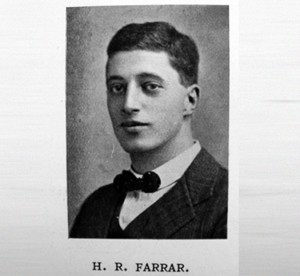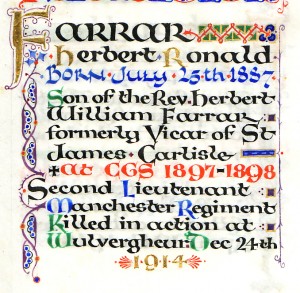
 Key Information
Key Information
Name: Herbert Ronald Farrar
DoB: July 25 1887
Regt: 3rd Batt. Leicester Regt.
DoD: December 24 1914
Academic Career: CGS 1897-8 Dulwich Coll., 1898-1906. Queens’ Coll., Cambridge, 1906; B. A., 1910. Master in a Preparatory School.
Biographical Information:
-
Family Background:
Herbert Ronald Farrar was the son of a vicar; the Rev. Herbert W. Farrar, of St. James’, Carlisle. Herbert Farrar Senior (known as Bill) was also the son of a vicar (Wesley Farrar) and had been born in Norfolk but was living in Durham by the time of the 1871 Census and then in Barrow (1881), Durham (1891) and London (1901). Vicars do tend to be moved around a lot! “Ronald was born at South Shields, County Durham, the second child of the Rev. Farrar’s second marriage, to Florence Margaret Town. He had two sisters, May Renny Annandah (born 1886) and Winifred Margaret (born 1888). He also had a younger brother, Sydney Gelder Farrar (born 1892), who also served as a Second Lieutenant during the Great War.” Interestingly, young Ronald was living with his maternal grandmother, Florence Margaret Town, when he was three years old. Annandale Town had been a Master Partner in a Paper Mills Firm. His grandmother was living at 64 Jesmond Road, Jesmond, near Newcastle. She was a widow, “of independent means”, and shared her house with three grown up children, a cook and a housemaid. Ronald’s time with his grandmother was perhaps because his father was chaplain to the Mission to Seamen on the Tyne. “Ronald moved with his family to Carlisle in 1893, when his father was appointed vicar there. In 1898 his father was appointed Superintendent Chaplain to the Missions to Seamen, this meant a move south to Dalmore Road, West Dulwich, South East London, and Ronald was enrolled at Dulwich College, arriving in May, in time for the start of the summer term. By spring 1901, the family had moved to Thurlow Park Road, Lambeth, where every family had a housemaid and cook. His younger brother Sydney joined him at Dulwich College in 1905, the year before Ronald left in April 1906.”
-
Academic Record:
Ronald was not a pupil at Carlisle grammar school for very long. After moving to Dulwich School, “he studied the Classics, with a view to going to University. He went up to his father’s college of Queens’ in Cambridge in 1906. While there he served as a Sergeant in the University Officers’ Training Corps (O.T.C.), and graduated with a B.A. in 1910.”
-
War Service:
On the day that war was declared, August 4 1914, aged twenty six, Ronald volunteered for service in the Public Schools Battalion. Although he was said not to be physically strong, his experience in the O.T.C. at Cambridge led to a probationary commission as a 2nd lieutenant in the 3rd (Reserve) Battalion of the Leicestershire Regiment He left for France on October 27. He was attached to the 2nd Battalion Manchester regiment, and was put in charge of two platoons and shot two Germans. By December 1 1914 the battalion had reached Dranoutre, near Ypres, Belgium and were resting in their billets. During the next week they received an ‘appreciative address’ from their commanding officer, took in reinforcements and, according to the battalion’s war diary records, they played football. As the month progressed, they moved from trench to trench under regular shellfire. ‘The division was now holding a line from La Petite Douve in a northwest direction up the slope to the Wulverghem-Mesines road and to the east to Hill 75,covering a front of about 3,500 yards. The weather was wet and cold, and the trenches were knee-deep in mud and water’.*
They received a break from the action during the week before Christmas when they “rested in billets” and attended a church parade at the Convent of St.Antoine, Locre on December 20. Hot baths could be taken at the convent for one franc (soap & towels not included), and with the opportunity to have meals there, providing a welcome break from the regular fare.
Returning to the front, the battalion moved to trenches east of Lindenhoek on December 23 and on Christmas Eve took over old trenches at Wulvergham from the Bedford regiment. The weather changed to a hard frost, making trench conditions a little more bearable than the sticky mud they were used to under foot. The sound of carols and hymns could be heard from the trenches on both sides, and the heavy guns stopped firing during the unofficial ‘Christmas Truce’. German troops coming into the lines brought Christmas trees to place on their parapets. But vigilance was still necessary. Records show that even on this day of low fatalities, 98 British soldiers died, many the victims of sniper fire. The battalion war diary records that amongst the unlucky few to die that day were 2nd Lt.H.R.Farrar and Sergt. Williams. Ronald was buried on Christmas Day 1914, in Dranoutre churchyard “close to (the) wall and near a crucifix attached to south wall, in the presence of “the general and officers of his regiment.” A brief notice of his death appeared amongst the list of “Fallen Officers” in The Times of December 30. In 1923 nineteen graves from the churchyard were moved to enable the rebuilding of the church. The bodies were re-interred in row K at Dranoutre Military Cemetery.” His family had “A man greatly beloved” inscribed on his gravestone.
-
Other:
“From 1910 to 1912 he worked as an assistant master at Ripplevale Preparatory School in Kent, before joining the staff at Windlesham House (Gentlemen’s) School, at Norfolk Terrace8, Brighton for Michaelmas term 1912. In the RagDance on the last Saturday of his first term, dressed as an Arab Sheikh, he led a procession of “wonderfully dressed Eastern ladies” (members of staff). He also opened the batting for the staff XI in summer 1913, scoring 1 run. In the spring of 1914 he travelled in the South of France, sailed up the Nile in Egypt as far as Aswan and back home via the Italian Lakes.”
A letter from Helen Moses, of the VAD Hospital in Beckenham, Kent, asking for Ronald’s parents’ address is in the Archives at Kew. She wrote on behalf of a soldier to whom Farrar had been kind. He wanted to express his gratitude.
The award of a medal for those who had served in France or Belgium between August 5 and November 22, 1914, was announced in 1917. The rector wrote to the military authorities applying for the posthumous issue of his son’s medal, the 1914 or “Mons” Star. After the War, on October 19 1919, it was announced that the King had approved the issue of a clasp, to be worn on the ribbon of the medal, to all wearers of the 1914 Star who had actually served under enemy fire during the specified period.
Ronald’s Victory medal appeared for sale on the internet auction site eBay in June 2010. Usually selling for about £15, it sold for £103.51, the high price being due to the fact that he was one of the few men to be killed during the unofficial ‘Christmas Truce’ of 1914. It is somewhat bizarre that the facts surrounding the date of an individual’s death should add value to piece of wartime memorabilia, awarded to every man who had fought during the first months of the Great War.”
“Ronald’s sister May died unmarried in 1919, aged thirty two and was buried in St. Mary’s churchyard, Barcombe, where her father was Rector. The Revd. Farrar marked her grave with a Celtic cross style headstone, and took the opportunity to commemorate his son. He was also the first master on Windlesham House school’s Roll of Honour 1914-1918. In 1921, the rector contributed a photograph and brief details of his son to the compiler of the Dulwich College War Record, thanking him for what he was doing “to commemorate the supreme sacrifice made by our beloved sons.
His brother Sydney took Holy Orders. His mother Florence Margaret died in 1922 and was also buried at St. Mary’s. Rev. Farrar, who is remembered in the village driving a pony and trap, remained as rector of Barcombe until 1942, when ill-health forced his retirement. He died the following year, aged eighty seven.”
-
Sources:
Most of this account, and all that is in speech marks, comes from the Research by Ian Hilder, BA, FSG for a proposed book to commemorate the men whose names appear on the war memorial in the churchyard of St. Mary’s Barcombe, East Sussex.
* History of the Manchester Regiment